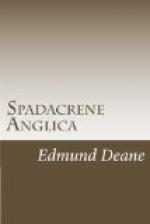Three of the others (being all of them much of one, and the same nature) are termed by the country people thereabouts the Stinking-wels, in regard they have an ill, and fetide smell, consisting most of Sulphure-vive, or quicke brimstone. One of them, and that which hath the greatest current, or streame of water, is in Bilton park.
The other two are in the sayd Forest; one is neare unto the towne; the other is further off, almost two miles from it, beyond a place called Haregate head, in a bottome on the right hand of it, as you goe, and almost in the side of a little brooke.
The fift, and last (for which I have principally undertaken to write this short Discourse) is an acide, or tart fountaine in the said Forest, commonly named by the vulgar sort, Tuewhit-well, and the English Spaw, by those of the better rank, in imitation of those two most famous acide fountaines at the Spaw in Germany, to wit, Sauvenir, and Pouhon: whereof the first (being the prime one) is halfe a league from the Spa, or Spaw village; the other is in the middle of the towne.
CHAP. 5.
_=A more particular recitall of the first foure Wells.=_
I purpose to speake somewhat more in this place of the first foure Springs mentioned in the former Chapter, in regard the consideration of them may perhaps give some light to those, who shall hereafter search further into the secrets, which nature may seeme to afford in the Country hereabouts.
The first is the Dropping-well, knowne almost to all, who have travelled unto this place. The water whereof distilleth and trickleth downe from the hanging Rocke over it, not onely dropping wise, but also falling in many pretty little streames.
This water issueth at first out of the earth, not farre from the said hanging rocke, and running a while in one entire current, continueth so, till it commeth almost to the brim of the cragg; where being opposed by a damme (as it were artificiall) of certaine spongy stones, is afterwards divided into many smaller branches, and falleth from on high in manner aforesaid.
It is therefore very likely, that Mr. Camden in person did not see this Fountaine, but rather that hee had it by relation from others; or at least wise (if he did see it) that hee did not marke, and duly observe the originall springing up of the water, when in his Britannia he saith thus: The waters thereof spring not up out of the veines of the earth, &c.
Concerning the properties and qualities thereof, I have nothing more to write at this time (there being formerly little tryall had of it) saving that divers inhabitants thereabouts say, and affirme, that it hath beene found to bee very effectuall in staying any flux of the body: which thing I easily beleeve.
The other three are sulphureous fountaines, and cast forth a stinking smell a farre off, especially in the winter season, and when the weather is coldest. They are all noysome to smell to, and cold to touch, without any manifest, or actuall heat at all; by reason (as may most probably be thought) their mynes, and veines of brimstone, are not kindled under the earth; being (perhaps) hindred by the mixture of salt therewith.




